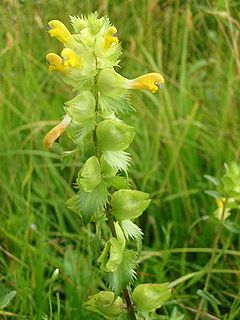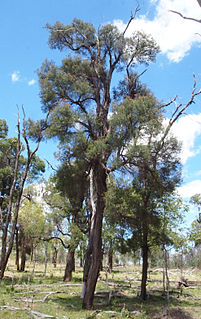
Crinum is a genus of about 180 species of perennial plants that have large showy flowers on leafless stems, and develop from bulbs. They are found in seasonally moist areas, including marshes, swamps, depressions and along the sides of streams and lakes in tropical and subtropical areas worldwide.

Elaeocarpus ganitrus, is a large evergreen broad-leaved tree whose seed is traditionally used for prayer beads in Hinduism. The seeds are known as rudraksha, or rudraksh, Sanskrit: rudrākṣa. Rudraksha may be produced by several species of Elaeocarpus, however E. ganitrus is the principal species used in the making of mala.

Melicytus ramiflorus is a small tree of the family Violaceae endemic to New Zealand.
Mahoe is a common name for several plants and may refer to:

Lupinus angustifolius is a species of lupin known by many common names, including narrowleaf lupin, narrow-leaved lupin and blue lupin. It is native to Eurasia and northern Africa and naturalized in parts of Australia and North America. It has been cultivated for over 6000 years as a food crop for its edible legume seeds, as a fodder for livestock and for green manure.

Melicytus crassifolius is an ornamental plant of Violaceae family, which is native to New Zealand.

Rhinanthus angustifolius, the narrow-leaved rattle or greater yellow-rattle, is a plant species of the genus Rhinanthus. It is an annual wildflower native to temperate grasslands in much of Europe, and north and central Western Asia. The yellow flowers are mostly visited by bumblebees.

Melicytus is a genus of flowering plants in the family Violaceae. Hymenanthera is a synonym.

Elaeocarpus angustifolius is species of flowering plant in the family Elaeocarpaceae and occurs from India to New Calendeonia and northern Australia. It is a large tree, often with buttress roots, and has leaves with wavy serrations, creamy white flowers and more or less spherical bright blue or purple fruit. Authorities differ regarding the distribution of this species.

Cape Lowland Freshwater Wetland is a critically endangered vegetation type of the Western Cape, South Africa.

Penstemon angustifolius is a species of flowering plant in the plantain family known by the common names broadbeard beardtongue and narrowleaf beardtongue. It is native to the west-central United States, including the Great Plains.

Melicytus lanceolatus, commonly called narrow-leaved māhoe or māhoe-wao, is a small tree of the family Violaceae endemic to New Zealand.

Lysicarpus is a genus of trees in the family Myrtaceae described as a genus in 1858. It contains a single known species, Lysicarpus angustifolius, endemic to the State of Queensland in Australia. It is known there as the brown hazelwood or budgeroo.

Helianthus angustifolius is a species of sunflower known by the common name narrowleaf sunflower or swamp sunflower. It is native to the south-central and eastern United States, found in all the coastal states from Texas to Long Island, and inland as far as Missouri. It is typically found in the coastal plain habitat, particularly in wet areas.
Melicytus novae-zelandiae, commonly known as coastal mahoe, is a flowering plant in the violet family. It grows along the coast of New Zealand from the Bay of Plenty northwards, especially on offshore islands. Its range is largely restricted to New Zealand, though one subspecies is endemic to Australia's Lord Howe Island. The specific epithet refers to its principal area of occurrence.
Melicytus novae-zelandiae subsp. centurionis is a flowering plant in the family Violaceae. It is a subspecies of Melicytus novae-zelandiae, known in New Zealand as coastal mahoe. The subspecific epithet honours the military Captain James Doran McComish (1881–1948), who made several visits in the 1930s to collect plants on Lord Howe Island.

Potamogeton × angustifolius is a hybrid pondweed between Potamogeton gramineus and Potamogeton lucens, known as long-leaved pondweed. It is widespread in rivers and lakes except where the water is very soft.
Calothamnus quadrifidus subsp. angustifolia is a plant in the myrtle family, Myrtaceae and is endemic to the south-west of Western Australia. It is similar to other subspecies of Calothamnus quadrifidus except that it has longer leaves than most although in some areas there are plants that are intermediate with Calothamnus quadrifolius subsp. obtusus. The leaves are flat, narrow and prickly.

Stenocarpus angustifolius is a tree of the family Proteaceae native to Queensland.

Melicytus alpinus, the mahoe porcupine shrub, is a small shrub of the family Violaceae endemic to New Zealand.















